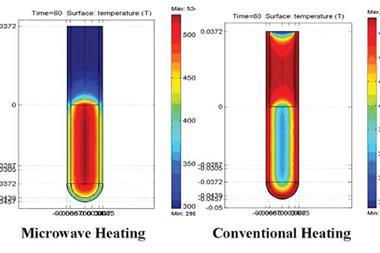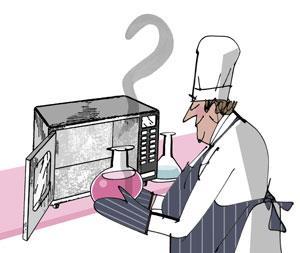Scientists in the US have unveiled a rate-enhancing effect of microwave irradiation on a high-temperature retro-Diels–Alder reaction.1 The group, led by Greg Dudley at West Virginia University, designed a reaction system that exploits a difference in polarity between the reactants and products. Following an extended debate over the existence and origin of microwave-specific effects in organic reactions, the group says their findings highlight the untapped potential of selective microwave heating in modern synthetic chemistry.

The unique capabilities of microwave heating have rendered it a mainstay of organic synthesis since the 1980s. Where conventional heating relies on thermal conduction between a heat source and reaction vessel, microwave heating arises from an interaction between the electric field of microwaves with the dipole of polar molecules.
A 2014 study by Dudley and his co-workers proposed that microwave irradiation could induce the selective heating of specific reaction components, leading to rate enhancements not observed by conventional heating.2 This peculiar effect lay at the heart of a fierce debate between the Dudley group and Oliver Kappe and his colleagues at Karl-Franzens University in Austria, with the latter insisting that the observed rate accelerations were the result of superheating the bulk reaction mixture.3
But following a series of studies establishing the physical basis for their observations, Dudley and his colleagues are now aiming to answer the question of whether this effect can be exploited.
‘What we would ultimately like to do is be able to design systems where the accelerating effects of microwave energy are transformative, synthetically practical and easily reproducible by others using standard microwave setups,’ Dudley tells Chemistry World. ‘One motivation was to design and discover new systems that can be accelerated with microwave heating. The motivation for that is that we don’t really understand the design criteria yet.’
In their new study, the group designed a series of retro-Diels–Alder reactions employing anthracene adducts with polar functional groups on the bridged bicycle. When heated at 200°C, the reactants decompose into non-polar anthracene and alkene products. Remarkably, the group observed a significant rate enhancement when the reaction vessel was heated with microwave irradiation compared to conventional heating methods. According to the group’s hypothesis, this discrepancy arises from selective microwave heating of the polar reactant, which enhances the thermal reactivity of polar solutes beyond what would be expected based on the measured temperature of the bulk solution.
Aiming to maximise the observed acceleration, the group found that varying the solvent viscosity and adding a surfactant could enhance the rate further still. Anita Mattson, a synthetic organic chemist and expert in reaction methodology at Worcester Polytechnic Institute in the US, welcomed the new findings: ‘Their suggestion that solvent viscosity and polar reactants may contribute to reaction rate enhancements provides tangible ideas and avenues to pursue that may have a significant impact on the development of processes with a microwave reactor.’
Antiono de la Hoz, a long-time contributor to the field of microwave chemistry at the University of Castilla-La Mancha in Spain, deemed the study a nice contribution, but felt that there is still much to learn. ‘In relation to polarity, the effect of solvent and polar inert additives must be explored, as well as the influence of polar intermediates in the reaction pathway,’ he says.
For Dudley, exploring alternative methods for measuring solute aggregation phenomena is a priority for future work. ‘Being able to identify the solute temperature spectroscopically as a complement to kinetics would be a really nice addition to the microwave literature, and that’s something that we are working on.’
References
1) M A Frasso, A E Stiegman and G B Dudley, Chem. Commun., 2020, DOI: 10.1039/d0cc04584e
2) M R Rosana et al, J. Org. Chem., 2014, 79, 7437 (DOI: 10.1021/jo501153r)
3) C O Kappe, Angew. Chem. Int. Ed., 2013, 52, 7924 (DOI: 10.1002/anie.201304368)












No comments yet